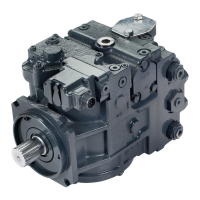piston tilts the cradle swashplate, thus varying the pump's displacement from full displacement in one
direction to full displacement in the opposite direction.
The control has a mechanical feedback mechanism which moves the servo valve in relation to the input
signal and the angular position of the swashplate. The electrical displacement control is designed so the
angular rotation of the swashplate (pump displacement) is proportional to the electrical input signal. Due
to normal operating force changes, the swashplate tends to drift from the position preset by the machine
operator. Drift, sensed by feedback linkage system connecting the swashplate to the control valve, will
activate the valve and supply pressure to the servo piston, maintaining the swashplate in its preset
position.
Features and Benefits
•
The electric displacement control is a high gain control: With only a small change of the input current,
the servo valve moves to a full open position thus porting maximum flow to the servo cylinder.
•
Oil filled PCP case lengthens control life by preventing moisture ingression and dampening
component vibrations.
•
All electrical displacement controls are equipped with dual coil PCPs. The user has the option of using
a single coil or both coils (in series or parallel).
•
Internal mechanical stops on the servo valve allow rapid changes in input signal voltages without
damaging the control mechanism.
•
Precision parts provide repeatable accurate displacement settings.
•
The swashplate is coupled to a feedback mechanism. The control valve drains the ends of the servo
piston when an electric input signal is not present.
Benefits
•
Pump returns to neutral after prime mover shuts down
•
Pump returns to neutral if external electrical input signal fails or if there is a loss of charge pressure
Electric displacement control schematic

